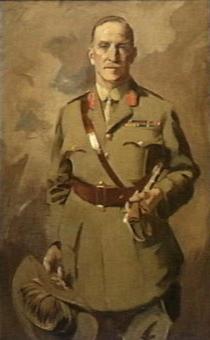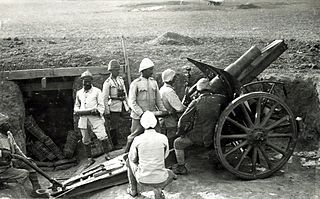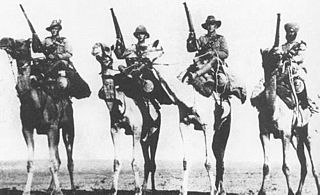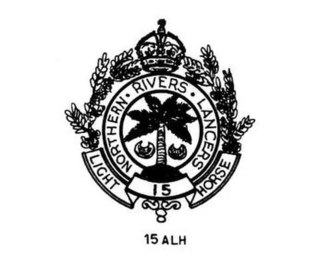
General Sir Henry George Chauvel, was a senior officer of the Australian Imperial Force who fought at Gallipoli and during the Sinai and Palestine Campaign in the Middle Eastern theatre of the First World War. He was the first Australian to attain the rank of lieutenant general and later general, and the first to lead a corps. As commander of the Desert Mounted Corps, he was responsible for one of the most decisive victories and fastest pursuits in military history.

The Australian and New Zealand Army Corps (ANZAC) was originally a First World War army corps of the Mediterranean Expeditionary Force. It was formed in Egypt in December 1914, and operated during the Gallipoli campaign. General William Birdwood commanded the corps, which primarily consisted of troops from the First Australian Imperial Force and 1st New Zealand Expeditionary Force, although there were also British and Indian units attached at times throughout the campaign. The corps disbanded in 1916, following the Allied evacuation of the Gallipoli peninsula and the formation of I ANZAC Corps and II ANZAC Corps. The corps was re-established, briefly, in the Second World War during the Battle of Greece in 1941. The term 'ANZAC' has been used since for joint Australian–New Zealand units of different sizes.

The Sinai and Palestine campaign was part of the Middle Eastern theatre of World War I, taking place between January 1915 and October 1918. The British Empire, the French Third Republic, and the Kingdom of Italy fought alongside the Arab Revolt in opposition to the Ottoman Empire, the German Empire, and the Austro-Hungarian Empire. It started with an Ottoman attempt at raiding the Suez Canal in 1915 and ended with the Armistice of Mudros in 1918, leading to the cession of Ottoman Syria.

The Mounted Memorial, Canberra is on Anzac Parade, the principal ceremonial and memorial avenue in Canberra, the national capital city of Australia. It is a copy of a memorial that was originally constructed in Port Said in 1932 but removed in 1956; a second copy was erected at Mount Clarence, Western Australia. The memorial was sculpted by Melbourne born sculptor, Sir Edgar Bertram Mackennal (1863-1918) - it was his last piece before his death.
The Egyptian Expeditionary Force (EEF) was a British Empire military formation, formed on 10 March 1916 under the command of General Archibald Murray from the Mediterranean Expeditionary Force and the Force in Egypt (1914–15), at the beginning of the Sinai and Palestine campaign of the First World War.

The Imperial Camel Corps Brigade (ICCB) was a camel-mounted infantry brigade that the British Empire raised in December 1916 during the First World War for service in the Middle East.
Mount Clarence is an inner suburb of Albany, Western Australia, between the Albany city centre and Middleton Beach. Its local government area is the City of Albany, and over three-quarters of its land area is either parkland or forest, including Albany's Heritage Park. Mount Clarence was gazetted as a suburb in 1979.

The Victoria Embankment Gardens are a series of gardens on the north side of the River Thames between Blackfriars Bridge and Westminster Bridge in London.

The Egyptian Camel Transport Corps were a group of Egyptian camel drivers who supported the British Army in Egypt during the First World War's Sinai and Palestine Campaign. The work done by the 170,000 men of the Corps helped British war operations in the Sinai desert and in Palestine and Syria by transporting supplies to the troops in extreme geographic and weather conditions.
The Egyptian Labour Corps was a group of Egyptian labourers who worked for the British Army in Egypt during the First World War's Sinai and Palestine Campaign.

The Western Frontier Force was raised from British Empire troops during the Senussi campaign from November 1915 to February 1917, under the command of the Egyptian Expeditionary Force (EEF). Orders for the formation of the force were issued on 20 November 1915, under Major-General Alexander Wallace, C.B. The force concentrated at Mersa Matruh on the coast and began operations against the Senussi in late 1915.

The 9th Light Horse Regiment was a mounted rifles regiment of the Australian Army during the First World War. The regiment was raised in October 1914, and assigned to the 3rd Light Horse Brigade. The regiment fought against the forces of the Ottoman Empire, in Egypt, at Gallipoli, on the Sinai Peninsula, and in Palestine and Jordan. After the armistice the regiment eventually returned to Australia in March 1919. For its role in the war the regiment was awarded fifteen battle honours.

The 11th Light Horse Regiment was a mounted infantry regiment of the Australian Army during the First World War. The regiment was raised in August 1914, and assigned to the 4th Light Horse Brigade. The regiment fought against the forces of the Ottoman Empire, in Egypt, at Gallipoli, on the Sinai Peninsula, and in Palestine and Jordan. After the armistice the regiment eventually returned to Australia in March 1919. For its role in the war the regiment was awarded fourteen battle honours. During the inter-war years, the regiment was re-raised as a part-time unit based in the Darling Downs region of Queensland. It was later converted to a motor regiment during the Second World War but was disbanded in 1943 without having been deployed overseas.

The 15th Light Horse Regiment was a mounted infantry regiment of the Australian Army during the First World War. The regiment was raised in Palestine in 1918, from soldiers that had been serving with the Imperial Camel Corps Brigade, and assigned to the 5th Light Horse Brigade. During the war the regiment fought against the forces of the Ottoman Empire, in the Sinai and Palestine Campaign and was awarded fourteen battle honours. During the inter-war years, the regiment was re-raised as a part-time unit based in the Northern Rivers region of New South Wales. It was later converted to a motor regiment during the Second World War but was disbanded in 1944 without having been deployed overseas. In the post war period, the regiment was briefly re-formed, before being amalgamated into the 1st/15th Royal New South Wales Lancers in 1956.

The Desert Column was a First World War British Empire army corps which operated in the Sinai and Palestine Campaign from 22 December 1916. The Column was commanded by Lieutenant General Philip W. Chetwode and formed part of Eastern Force. When Chetwode took command of Eastern Force after the Second Battle of Gaza, Harry Chauvel took command and oversaw the expansion of the column to three divisions.

The Raid on the Beersheba to Hafir el Auja railway took place on 23 May 1917 after the Second Battle of Gaza and before the Battle of Beersheba during the Stalemate in Southern Palestine in the Sinai and Palestine Campaign of World War I.

The Raid on Bir el Hassana (Hasna) occurred in the Sinai Peninsula in February 1917, during World War I. It was a minor action between an augmented battalion of the Imperial Camel Corps on the one side and a score of Turkish troops plus some armed Bedouin on the other. The raid occasioned the first aeromedical evacuation in the British Army.

The Thames Ditton Foundry was a foundry in Thames Ditton, Surrey, which operated from 1874 to 1939 and which under various owners produced numerous major statues and monuments as one of the United Kingdom's leading firms of bronze founders.

A bronze statue of General Charles George Gordon by Hamo Thornycroft stands on a stone plinth in the Victoria Embankment Gardens in London. It has been Grade II listed since 1970. A similar statue stands at Gordon Reserve, near Parliament House in Melbourne, Australia, on its original tall plinth.

The New Zealand Machine Gun Corps was an administrative corps of the New Zealand Military Forces during the First World War. It was formed in early 1916, following the Gallipoli campaign in response to a need for more effective machine gun support. The corps initially comprised independent machine gun companies and a mounted machine gun squadron, although in 1918 the machine gun companies were brought together into a machine gun battalion. The New Zealand Machine Gun Corps was disbanded at the end of the war.

















